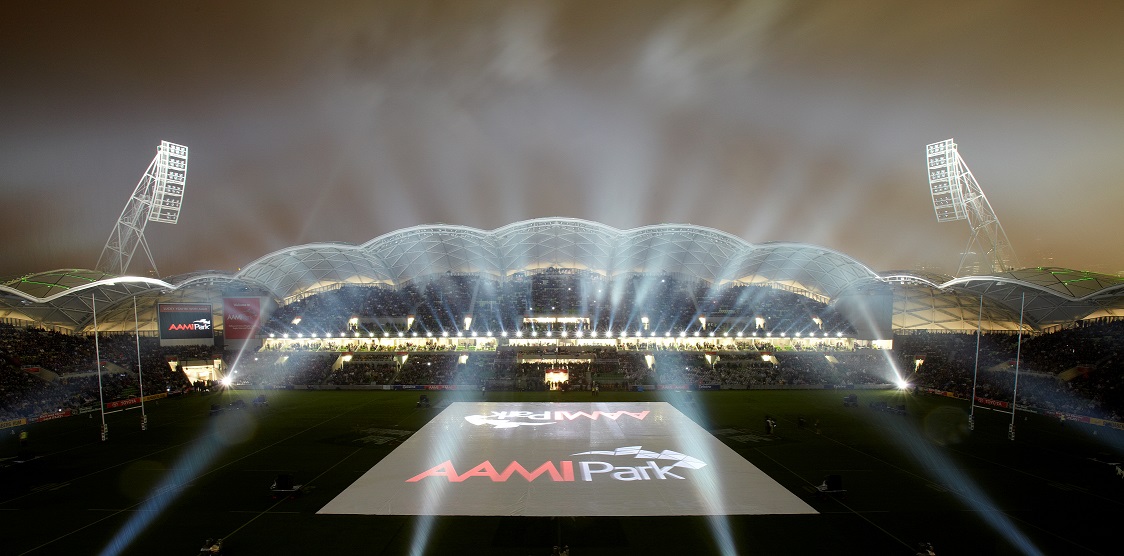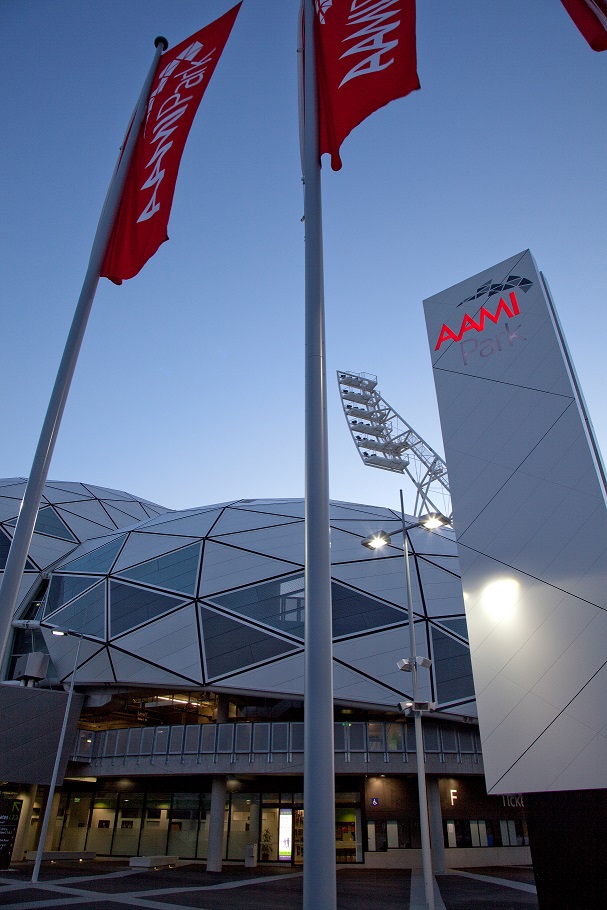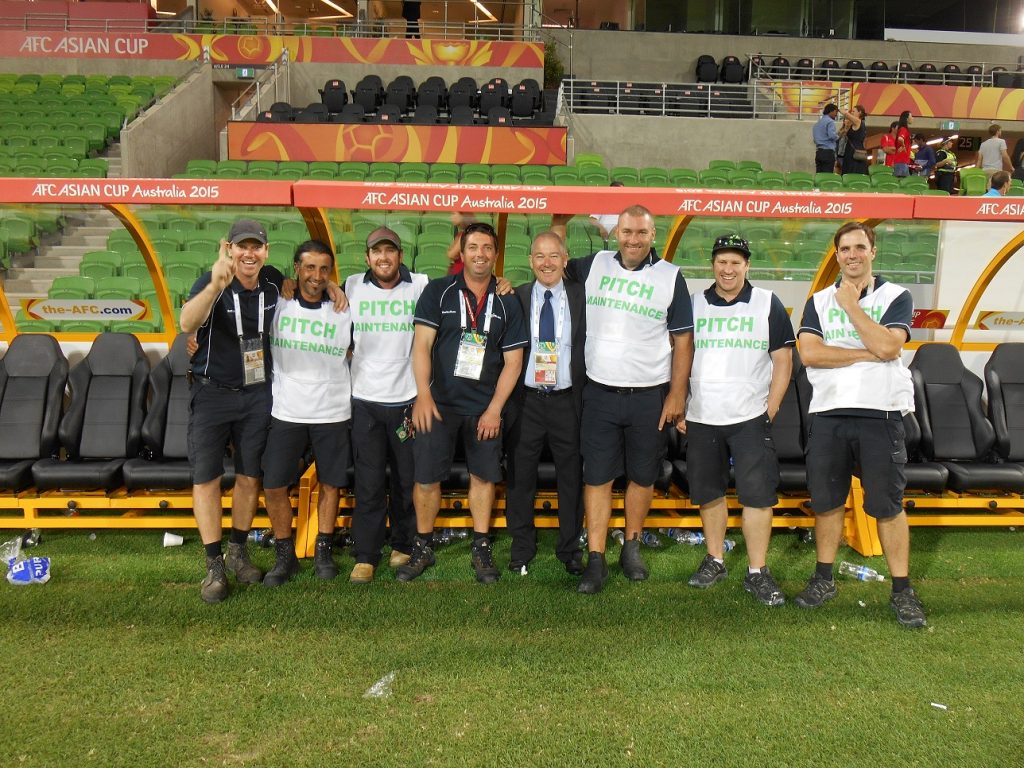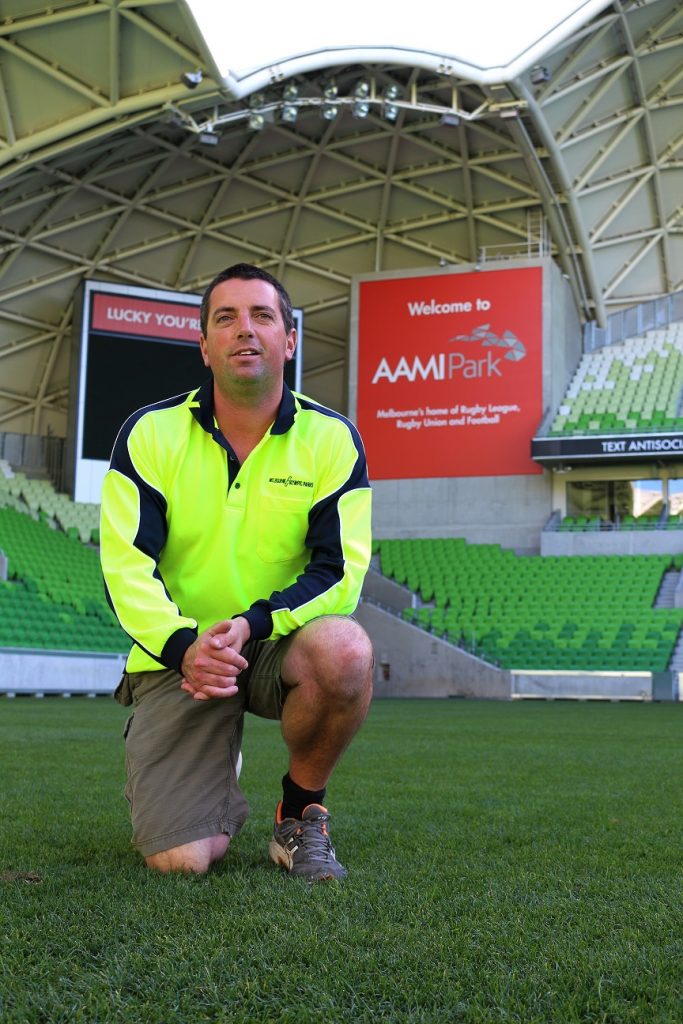- November 16, 2017
- Posted by: SportsV
- Categories: Event News, Features, Home News, Industry News, Interviews, News

In the latest industry interview, SVB’s Katie McIntyre hears insights from Melbourne & Olympic Park’s Sports Field Coordinator overseeing AAMI Park and the associated training fields, Justin Lang, on the challenges of managing and maintaining healthy pitches, especially in venues with multi-codes and events.
Justin, can you start off by telling us more about yourself? Your background, career highlights, etc?
I started my sports turf career as an apprentice in 1990 at the age of 17. I prepared cricket wickets for the Richmond Cricket Club and ground for the Richmond Football Club in Melbourne. I then become the Assistant Arena Manager at Etihad Stadium in Melbourne for 10 years. I am now the Sports Field Coordinator at Melbourne & Olympic Parks overseeing AAMI Park and its training fields.
Some of my highlights are preparing the pitch for international events, including: World Cup Qualifiers for the Socceroos; the Asian Cup in 2015; consulting for the FIFA Brazil World Cup in 2014; consulting for the 2016 Asian Champions League Final in Jeoju, South Korea; preparing for the Rugby Union World Cup in 2003; hosting the Rugby League World Cup Opening game and ceremony in 2017; Wallabies games; preparing Cricket pitches for Australia; and hosting numerous concerts and Monster Truck events.
As the Sports Field Coordinator for Melbourne & Olympic Parks’ AAMI Park and its training facilities, what are your main responsibilities? I understand you recently had to transform the Stadium from a Monster Jam Venue back to A-League and also have two concerts coming up in the next couple of months. What specific maintenance is required for non-sporting events and how easy/hard is the process of conversion?
My main responsibilities are to oversee the day-to-day operation of the turf in AAMI Park and the surrounding sports fields. This includes turf maintenance programs, capital works, turf replacement, irrigation, budgets and five full-time staff, along with a number of casuals.
We have six main tenants, including Melbourne Storm Rugby League Club, Melbourne Rebels Super Rugby Club, Melbourne Victory and Melbourne City in the A-League, Melbourne Demons and the Collingwood Magpies in the AFL.
Transitioning from a Monster Jam event or a concert to a football match five days later is not something that is planned the week before. Planning is done well in advance, with field preparation starting eight to ten weeks out. Plant nutrition is crucial for concert wear and recovery, hardening off the plant and making sure there is minimal growth for the event is imperative. Reducing soil moisture and Nitrogen levels makes a big difference.
Presenting the pitch for football leading into a non-sporting event is tough, finding the right balance between hardening-off the plant but still making sure the surface is first class for Football can be difficult.
AAMI Park features a cutting-edge Bioframe design with a geodesic dome roof, which covers most of the seating area. Obviously this means increased comfort for spectators, however, does it offer any specific challenges or indeed benefits in terms of the pitch and the WALT deliverables needed for healthy grass plant growth?
There is a big enthuses with modern stadia on spectator comfort. For us this means reduced sunlight and air movement. To help combat this we have introduced artificial lighting in the form of three large SGL light rigs. From April to September we have the light rigs going 24 hours a day in designated areas. The only time they are not operating is during an event.
Can you describe for us the stadium’s pitch set up? i.e. the grass type/s, whether it’s a natural/hybrid/artificial pitch, use of technology, like undersoil heating, grow lights, etc.
The pitch is a perched water table profile, this means we have sand over gravel over clay with a Herringbone drainage system installed. The sand we use drains at 500mm per hour to help cope with sudden downpours.
We use a Sports Turf stabilising product from our turf supplier HG Sports Turf “Eclipse” for stability and playability. The product has synthetic fibres attached to a backing that gives the surface its stability. One of the main benefits to the product is you can install it one day and play on it the next. The product is sown with straight Soprano Ryegrass and has no Bermuda grass base. One of the main factors in using the Eclipse is its outstanding ability to withstand a Super Rugby Scrum.
Ready play sports turf is something we have been doing in Australia for the last 25 years. This gives venues the ability to have a concert, replace turf and play on it the next day. This model is slowly being implemented worldwide to make venues more flexible and maximise revenue.

What are the key elements of your Pitch Management Plan for AAMI Park and the elite training pitch? And how would it’s needs potentially differ, if at all, from a pitch in Europe?
To have a strong plant that has excellent wear and recovery is our main focus. The maintenance of this includes a high emphasis on controlled release granular fertilisers with foliar applications to top up some minor elements. Products to help combat high wear and shade are also commonly used. With lack of sunlight and air movement disease can be a big issue, keeping on top of disease is an important challenge but with the right program this is reduced greatly.
With Melbourne’s hot summers and cold winters choosing the right species of grass is important. Fortunately, we don’t have to transition grass species from a warm season to a cool season grass. Although, pushing Ryegrass through 40-degree days in summer and five degree days in winter comes with its challenges. Even Europe has its wide range of climate, each venue has its own micro-climate and would have a program in place regardless of its location.
As a medium sized rectangular stadium playing host to rugby league, rugby union and soccer matches, what specific challenges do you face and how do you overcome these?
The biggest challenge we face is having all four teams in competition at the same time. Throw in a couple of concerts as well can make it interesting.
From February to June it is not uncommon to have three codes playing at the venue on the same weekend. Having Super Rugby on a Friday night, A-League Football on a Saturday and Melbourne Storm Rugby League on a Sunday in the same weekend is something that we regularly deal with.
Presenting the pitch for one code then making sure all previous lines, logos and divots are repaired and not noticeable for the next event takes expertise and dedication from all our staff.
AAMI Park won the ‘Professional Footballers Association Best Pitch Award’ for the 2011/12, 2012/13 and 2014/15 seasons. What does it mean to you and the grounds staff to win such industry awards? Especially ones voted for by the elite athletes themselves.
You don’t set out to win awards like this, but it’s a massive bonus to all involved when you do. It’s a great reward for all the hard work the team has put in throughout the season.
If we can play a part, even a little part in helping Melbourne Victory or City to be the best Football teams in the country then we have done our bit. What makes it even more rewarding is AAMI Park has to do it consistently over at least 23 A-League games per season, far more than any other venue.

When it comes to the latest in best practice, technology and innovations in Turf Management, Turf Care and Turf Maintenance, how vital is knowledge-sharing between peers?
Having a good relationship with peers from other major venues throughout Australia, particularly in Melbourne for me, has been integral. At different times it is good to bounce ideas off groundsman in similar positions, having similar issues.
Having started your career as Head Groundsman at Richmond Football Club back in 1991, and being a Turf Consultant both for the STRI and the AFC, you must have been privy to some major changes in turf technology and pitch management over the past 25+ years. Which would you say have been the most important for the betterment of the industry? And what kinds of advances would you like to see moving forward?
With constant improvement and professionalism of sport at the highest level, the turf industry has had to move with it. With clubs having millions of dollars worth of players running around, it is expected that surfaces are immaculate. The pressure and expectation on groundsman at the highest level is enormous. Dealing with nature has its challenges, introducing technology in turf to artificially change these dynamics has been crucial. Introducing technology such sand profiles, hybrid turf systems, artificial lighting, ground heating and cooling, systems that can control moisture levels in the profile and portable pitches that can slide in and out of stadiums are just some big improvements in turf in the last 25 years.
Consulting for FIFA in Brazil 2014 and the Asian Football Confederation (AFC) in Asia has exposed me to the many improvements the industry has made, but more importantly the potential it has. With the FIFA World Cup coming up in Qatar 2022 and Asia becoming more active in the turf industry, I can see some pretty exciting times ahead for the industry.
Finally, what’s the best piece of advice you’ve ever been given or what advice would you give to someone considering a career in groundsmanship?
Firstly – you need to be passionate about what you do, passion is something you have, you can’t teach someone to be passionate.
Secondly – get out there and sell yourself, grab every opportunity you get with both hands because nobody else will do it for you.
Thirdly – dealing with nature sometimes things are out of your control, control what you can control and try not to stress about the things that you can’t.

Huge thanks to Justin Lang for taking the time to provide these expert insights.

